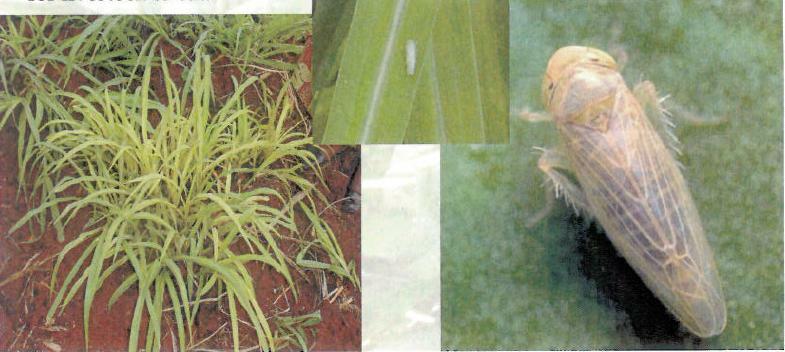Description
Napier grass is one of the important perennial tropical forage crop belong to family Poaceae. It is also called Uganda grass or elephant grass. It is native to Africa but is now grown in many tropical countries. It is C4 plant and can grow well in marginal land. The grass grows tall and forms large clumps like bamboo.

Napier grass stem

Napier grass inflorescence

Individual Napier grass clump

Napier grass row
Uses
Mainly used as fodder crop. Generally it is fed directly to cattle or made into silage or hay. It produces huge biomass and can be harvested multiple times in a year which making it a good raw materials for biofuel production. Napier grass is planted in marginal lands and slopes to increase soil fertility and to reduce soil erosion. It is also the main source for paper production in mnay regions.
Napier grass is also used in integrated pest management strategy as pull crop mainly in maize and sorghum producing areas. Napier grass is grown along maize or sorghum (in rows or in borders) to reduce the stem borer population.
It is also commonly grown in borders of many crops as windbreak and firebreak.
Propagation
Basic requirements
Napier grass is best grown in warm, tropical and subtropical regions. And grows well up to an altitude of 2000 m from sea level. Generally it perform very well at temperature ranging from 25 to 40 degree celsius. Napier grass is very sensitive to frost and water logging conditions.
Planting
Napier grass usually produces few full form seeds. So the main mode of propagation is by stem cuttings. The cuttings with five internodes are planted by inserting into furrows at 75 cm apart, both along and between the rows.
References
CABI Crop Protection Compendium. Pennisetum purpureum datasheet. Available at: http://www.cabi.org/cpc/search/?q=Pennisetum+purpureum. [Accessed 29 February 16].
Paid subscription required.
FAO, 2015. Grassland Index. A searchable catalogue of grass and forage legumes. FAO, Rome, Italy. http://www.fao.org/ag/AGP/AGPC/doc/GBASE/commonnames/commonsearch.htm [Accessed 29 February 16 ].
Free to access
Heuzé V., Tran G., Giger-Reverdin S., Lebas F. (2015). Elephant grass (Pennisetum purpureum). Feedipedia, a programme by INRA, CIRAD, AFZ and FAO. Available at: http://www.feedipedia.org/node/395 Last updated on October 27, 2015, 11:26. [Accessed 29 February 16 ].
Free to access
New Agriculturist on-line, 2005. Grass stunt draws a crowd [online]. Available at: www.new-ag.ingo/05-5/focuson/focuson6.html [Accessed 29 February 16].
Free to access
Common Pests and Diseases
Diseases
Category : Fungal
Head Smut Disease
Ustilago kamerunensis

Napier plant with smutted tillers (initial symptom)
Symptoms
Infected plants show thinner, shorter stems and produce few small size leaves. The shoot become hard and flowers prematurely. Head turns into smut.
Cause
Fungus
Comments
Management
Grow resistant varieties where available. Use disease-free planting materials. Keep the plants healthy by providing proper nutrients. Avoid using manure from livestocks that have been previously fed with smut infected plants.
Category : Viral
Napier Grass Stunt Disease (NGSD)
Candidatus Phytoplasma oryzae (Ns-phytoplasma)

Napier grass stunt diseased growth from cut clumps

Stunt disease infected plant and the plant hopper that transmits the disease
Symptoms
The infected plants typically have small yellow leaves and short internodes. It produce large number of tillers. Plant become stunted and eventually die.
Cause
Phytoplasma
Comments
Management
Use disease free healthy planting materials. Remove and destroy the infected plants. Follow crop rotation.







